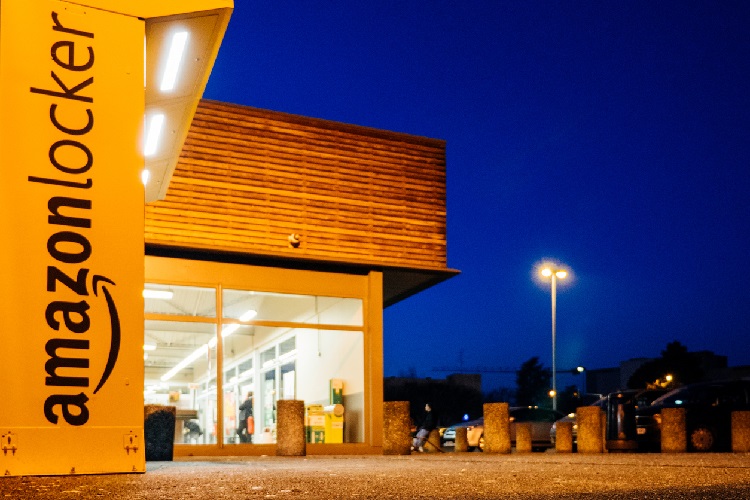Amazon and Walmart continue to one-up each other in delivery and collection, offering new and innovative ways for customers to receive their orders. Amazon customers can retrieve orders from lockers or choose one- or two-hour delivery in many markets. Amazon also has electronic keys to some customers’ door locks and is investigating delivery by drone. Meanwhile, Walmart is building Pickup Towers inside its stores, exploring speedy delivery and testing delivery by employees on their way home from work.
Amazon launched its locker program in September 2011 in New York, Seattle and London. The lockers enable customers who are wary of theft by “porch pirates” to have their packages sent to and stored in public locations that include parking garages and retail stores. 7-Eleven offers Amazon lockers in more than 300 stores, and Spar stores in Germany and US Whole Foods stores (which Amazon acquired in August 2017) also house pickup lockers. Customers are not charged extra to pick up their Amazon order from a locker, and as of the end of 2017, the company had lockers in more than 2,000 locations in more than 50 cities. Delivery personnel place an order in a locker at the customer’s chosen location, and then the customer receives an email with the locker number and a code to unlock the door. Customers can also return packages to selected lockers. In addition, Amazon has been beta testing Hub, a delivery locker for apartment building lobbies that accepts packages from all carriers, since 2017.
Installing lockers in Whole Foods stores in order to drive additional store traffic was a natural next step for Amazon after it acquired the grocery chain, and the move appears to have been successful. Location-based marketing firm InMarket studied 98 Whole Foods stores in major cities to assess how in-store lockers affect store traffic. Of the stores the firm studied, 76 had lockers, representing 16% of Whole Foods’ fleet of 473 stores. The firm found that “micro” visits (i.e., visits of up to five minutes) increased by 11% at stores with lockers during the study period, versus a 7% increase in stores without lockers. These micro visits have accounted for 9% of all grocery store visits so far this year, but for only 6.5% of visits to Whole Foods, implying there is room for improvement.
Following initial testing in Chicago in November 2017, Macy’s is installing lockers as well in order to expedite the pickup of items ordered online. At one New Jersey Macy’s store, the lockers are located adjacent to the Macy’s “At Your Service” counter. To encourage the use of lockers, Macy’s offers customers who use the service a 20% discount on their next visit.
Walmart is constructing in-store towers rather than lockers to expedite collection of online orders, in addition to offering drive-through pickup and other expedited delivery options. The company has deployed 200 Pickup Towers in stores across the US, and customer response has been overwhelmingly positive, with shoppers collecting a total of 500,000 orders already. Walmart recently announced plans to add another 500 towers by the end of this year. The company says the towers function like “giant vending machines,” and that customers can scan a barcode or enter a numerical code to retrieve their items. A robotic arm grabs each customer’s items within the tower—even goods as large as TVs—and brings them to the customer. Walmart estimates that following the expansion, Pickup Towers will be available to 40% of the US population.
Amazon and Walmart are also testing various smart-lock technologies that enable delivery agents to enter customers’ homes and leave purchased items inside. Amazon recently announced its Amazon Key service, which uses a combination of a security camera, a smart lock and an app to facilitate the keyless access to customers’ homes by trusted individuals. Amazon Prime members in selected cities and 37 metro areas can elect to receive in-home delivery through the service, which works with eight compatible smart locks from leading manufacturers such as Kwikset and Yale. Customers can enable the app to unlock a door and they can check in at any time via live view in addition to watching clips of who entered and exited their home. In February, Amazon also acquired Ring, which makes smart doorbells, for $1 billion.
Similarly, Walmart is partnering with smart-lock company August and delivery company Deliv to enable delivery personnel to leave purchased groceries in customers’ refrigerators. The program supplements Walmart’s testing of order delivery by employees on their way home from work.
We expect Amazon, Walmart and other retailers to continue to escalate their collection and delivery options in order to offer ever-increasing levels of convenience and service for busy consumers.
Other pieces you may find interesting include: Amazon Pay Places: Amazon’s Next Conquest Could Be Mobile Payments, Quick Take: Prime Members Drive Amazon Sales Across All Categories, Amazon in 20 Charts—the Rise and Rise of the E-Commerce Giant
Connect with us on social media:
@DebWeinswig
@FungRetailTech
Facebook
LinkedIn
Subscribe to our YouTube channel
Pinterest
Instagram
